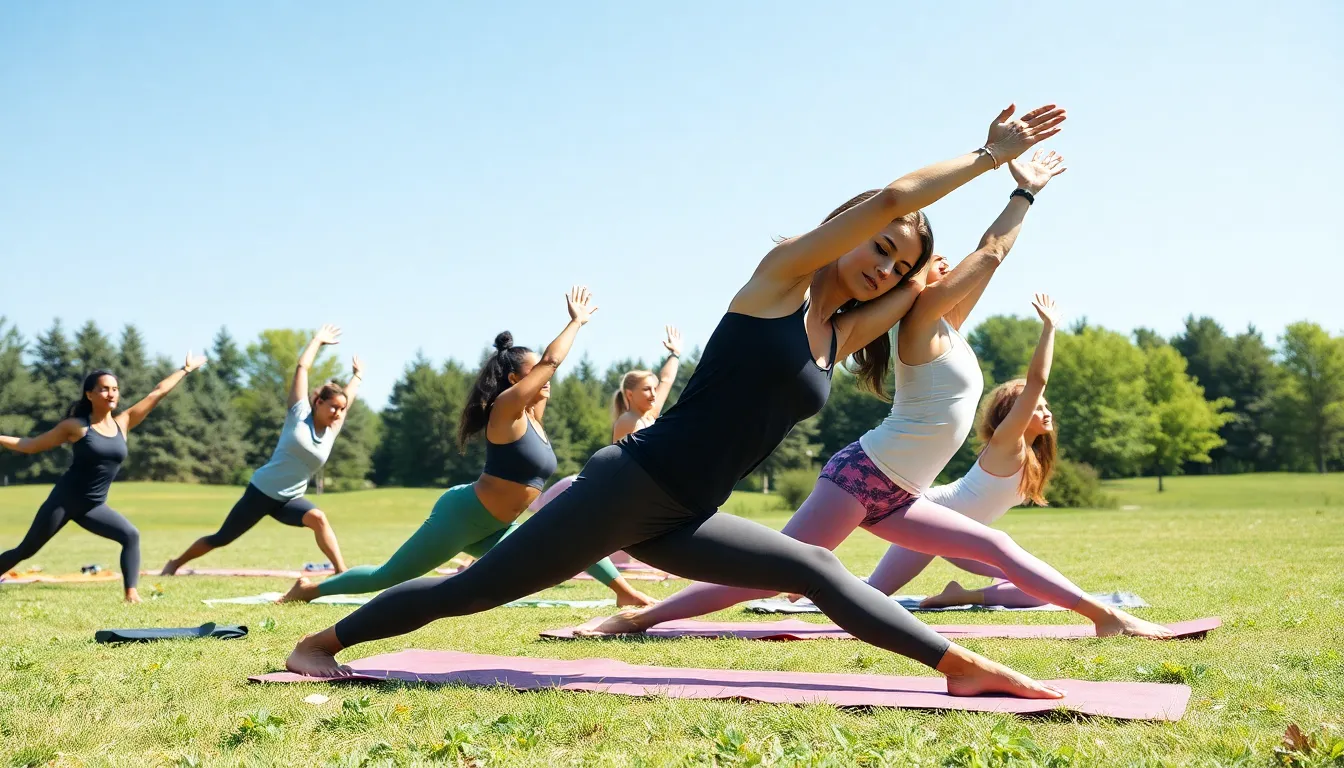Table of Contents
ToggleIn today’s fast-paced world, the importance of rest in fitness often gets overshadowed by the hustle for constant progress. Many believe that more workouts equal better results, but the truth is far more nuanced. Rest isn’t just a break; it’s a crucial component of any effective fitness regimen.
Understanding the power of rest can revolutionize how individuals approach their training. It allows the body to recover, rebuild, and ultimately perform at its best. By prioritizing rest, fitness enthusiasts can enhance their strength, endurance, and overall well-being, leading to sustainable progress and fewer injuries. Embracing this balance can transform workouts from a grind into a journey of growth and rejuvenation.
Understanding the Power of Rest Fitness
Rest fitness plays a vital role in maximizing performance and achieving long-term fitness goals. Emphasizing recovery can significantly enhance physical results and overall health.
What Is Rest Fitness?
Rest fitness refers to the intentional practice of incorporating periods of rest and recovery into a fitness regimen. It involves scheduled breaks between workouts, allowing the body to heal and adapt. Techniques such as active recovery, complete rest days, and sleep are essential components. By prioritizing rest, athletes can prevent burnout, optimize muscle repair, and boost overall energy levels.
Importance of Recovery in Fitness
Recovery holds critical importance in any fitness program. It enables muscle growth, repairs tissue, and replenishes energy stores. Insufficient recovery can lead to overtraining, resulting in fatigue, diminishing performance, and increasing injury risk. Studies indicate that adequate rest can enhance mental clarity, improve motivation, and increase workout efficiency. Effective recovery strategies include hydration, balanced nutrition, and stretching, all vital for sustaining physical fitness and enhancing overall well-being.
Benefits of Rest in Fitness

Rest plays a vital role in enhancing both physical and mental aspects of fitness. Recognizing these benefits can lead to a more effective and balanced training approach.
Physical Benefits
- Muscle Recovery: Rest allows muscles to repair and grow. Recovery periods facilitate protein synthesis, crucial for building and strengthening muscle fibers.
- Injury Prevention: Adequate rest reduces the risk of overuse injuries. Frequent workouts without rest can lead to ailments like strains and sprains.
- Performance Improvement: Muscles function optimally with sufficient recovery. When rested, individuals often experience heightened strength, speed, and overall performance during workouts.
- Hormonal Balance: Rest helps regulate hormones involved in muscle growth, such as testosterone and cortisol. Balanced hormone levels contribute to better recovery processes.
- Energy Restoration: During rest, glycogen stores replenish, providing energy for future workouts. Maintaining energy levels enhances endurance and stamina.
Mental Benefits
- Enhanced Focus: Regular rest fosters improved concentration and mental clarity. A refreshed mind leads to better workout performance and decision-making.
- Stress Reduction: Rest periods decrease stress and anxiety levels. Lower stress promotes a positive mindset towards fitness goals.
- Increased Motivation: Taking time to rest rejuvenates motivation. When individuals feel physically and mentally refreshed, their enthusiasm for workouts typically grows.
- Better Sleep Quality: Resting enhances overall sleep patterns. Quality sleep supports cognitive function and physical recovery, essential for fitness progress.
- Mind-Body Connection: Incorporating rest enhances awareness of bodily signals. This awareness supports better understanding of personal limits and recovery needs.
Incorporating Rest Into Your Fitness Routine
Incorporating rest into a fitness routine significantly enhances performance and sustainability. Balancing workout intensity with adequate recovery leads to optimal results and overall well-being.
Active Recovery Techniques
Active recovery techniques promote blood circulation and facilitate muscle healing without intense exertion. Individuals can integrate several methods into their routine:
- Low-Intensity Cardio: Activities such as walking, cycling, or swimming at a gentle pace maintain activity levels while allowing muscles to recuperate.
- Mobility Work: Stretching, yoga, and foam rolling improve flexibility and reduce muscle tightness.
- Dynamic Warm-Ups: Engaging in light exercise that incorporates movement prepares the body for more strenuous activities and aids recovery.
- Recreational Sports: Light sports or activities, such as playing catch or easy jogging, provide a break from structured workouts while keeping the body active.
Passive Recovery Strategies
Passive recovery strategies focus on rest and relaxation, allowing the body to recover fully. Key strategies include:
- Scheduled Rest Days: Designating specific days for complete rest prevents burnout and promotes long-term progress.
- Quality Sleep: Prioritizing 7-9 hours of sleep each night aids in physical recovery, hormonal balance, and cognitive function.
- Hydration: Ensuring adequate fluid intake supports muscle repair and overall health during recovery periods.
- Nutrition: Consuming well-balanced meals rich in proteins, healthy fats, and carbohydrates enhances recovery and prepares the body for future workouts.
Incorporating both active and passive recovery strategies leads to a more effective fitness routine, fostering optimal performance and health.
The Science Behind Rest and Performance
Rest plays a critical role in enhancing fitness performance and recovery. Understanding the underlying science can help individuals maximize their training outcomes and overall well-being.
How Rest Affects Muscle Growth
Rest is essential for muscle growth due to the biological processes that occur during recovery. When individuals engage in resistance training, muscle fibers experience micro-tears. Rest allows these fibers to repair and grow stronger. During this recovery phase, specifically during sleep, the body releases human growth hormone (HGH), which further facilitates muscle repair and growth.
Inadequate rest can lead to overtraining, stalling progress and increasing the risk of injury. Research indicates that muscle recovery relies on a balance of training and rest to optimize strength gains. Therefore, sufficient rest periods, including days off and sleep, help ensure effective muscle adaptation and growth.
The Relationship Between Sleep and Fitness
Sleep significantly influences fitness performance and recovery. During sleep, the body engages in critical functions, including muscle repair, glycogen replenishment, and hormonal balance. Quality sleep enhances physical performance by improving reaction times, coordination, and overall endurance.
Studies suggest that athletes who achieve adequate sleep experience improved strength, speed, and cognitive functions compared to those who do not. Chronic sleep deprivation can hinder athletic performance, increase fatigue levels, and compromise mental focus. Prioritizing quality sleep as part of a fitness regimen fosters better results and supports sustained health.
Common Misconceptions About Rest Fitness
Many misconceptions exist regarding the importance of rest in a fitness regimen. Understanding these misconceptions helps clarify the true value of rest fitness.
- More workouts equal better results: Many believe that constant exercise leads to improved performance. In reality, rest allows for recovery and growth, enhancing long-term outcomes.
- Resting indicates laziness: Some view resting as a sign of weakness or lack of dedication. However, scheduled rest is vital for optimizing performance and preventing overtraining.
- Active recovery isn’t beneficial: Some individuals ignore the benefits of active recovery. Gentle activities like walking or stretching promote blood circulation and facilitate muscle healing.
- Sleep isn’t crucial for fitness: Many underestimate the impact of sleep on physical performance. Quality sleep significantly improves reaction times, coordination, and overall endurance.
- Rest days disrupt progress: Some fear that taking rest days will hinder training progress. Conversely, incorporating rest days promotes muscle repair and prevents burnout, contributing to sustainable fitness gains.
- All recovery strategies are the same: Individuals may think that all recovery methods yield similar results. Different strategies—active and passive—serve specific purposes and enhance recovery in unique ways.
Clarifying these misconceptions fosters a better understanding of rest fitness and its role in achieving optimal performance and well-being.
Embracing the power of rest in fitness is essential for anyone looking to achieve lasting results. By recognizing that rest is not a sign of weakness but a vital component of a successful training regimen, individuals can unlock their full potential. Prioritizing recovery strategies enhances both physical performance and mental clarity, paving the way for long-term health and fitness goals.
Incorporating a balanced approach that includes both active and passive recovery can transform workouts into a holistic journey of growth. Ultimately, understanding and valuing the role of rest leads to improved strength endurance and overall well-being, making it a crucial ally in the pursuit of fitness excellence.




